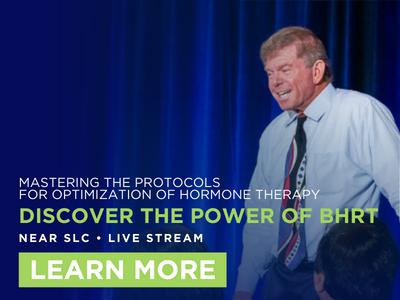
The CVD and Cancer Insanity Cycle: What Should we do if What we are Doing Isn’t Working?

Written by Neal Rouzier, MD
The CVD and Cancer Insanity Cycle: What Should we do if What we are Doing Isn’t Working?
As clinicians we try to be problem solvers. It is part of our training, try to figure out what’s wrong, and then to fix it. Problem solved. However, what should we do if what we are doing isn’t working? Keep doing the same thing? What if the patient does not get better? What if the patient doesn’t feel better? What if the incidence of CVD continues to increase despite all the medications we prescribe? What if the incidence of cancer continues to increase even though cancer treatments themselves once you get cancer have improved? It is often said that insanity is doing the same experiment over and over again expecting to see and hoping to see different results.
If you are interested in learning more about the value and efficacy of Bioidentical hormones in HRT as an alternative to medication-based therapies, please consider our four part hormone optimization workshop series.
Are we Increasing the Risk of CVD and Cancer?
Why does the U.S have one of the highest incidences of CVD and cancer? Whatever we are doing is not working, so we just have to try harder, they say. But that’s not working. In fact, a lot of what we are doing is actually making the situation worse, i.e. medications increasing the risk/incidence of DM and cancer, unfortunately. When, however, problems emerge from misrepresented science, the harms to patients’ health can be severe. Examples from recent cases include: addiction, iatrogenic illness, birth defects, drug-induced suicide, congestive heart failure, stroke, heart attack and botched surgeries involving faulty medical devices. We try to do no harm, and yet sometimes what we do increases harm. Might we be actually increasing the risk of CVD and cancer, yet we are unaware that we are doing so? Do you see where I’m headed?
In trying to solve these problems, we often try to identify the problem and fix what is broken. Yet we still witness an alarming incidence of CVD and cancer. So, maybe we shouldn’t be trying to fix what is broken, because that is not working out as well as it should, or as much as we would like. So, how is that working out for you? Well, it’s not, and if it’s not, then you have to change something and not keep doing the same thing over and over again. That’s insanity. The cholesterol-centric view of CVD is not working if ARR is only 1-2% in most studies. Therefore, there must be something else at the core that needs to be fixed and we need to change something if we expect that something to be fixed. We should be focusing on what is working and do more of it, as opposed to what is not working. And perhaps we should turn to EBM to guide us in deciding what works and what doesn’t, and what works the best. CVD is a multifactorial disease entity and not simply due to cholesterol.
The Glucose Centric-Model
Recently, we have come to understand and accept the glucose-centric model for cancer initiation and progression. This concept has been popularized by many authors and scientists. We are dealing with a significantly excessive amount of CVD and cancer. The cause is now out of the bag as evidenced by the glucose-centric model of cancer. Unfortunately, the solution of diet, exercise, life-style change demonstrates a 95-99% rate of recidivism. So, it’s the patient’s fault and they are to blame, right? So, then, we’ll add drugs and medications to the mix and that will fix it. So, how’s that working out for you?
Well, it’s not and that’s what my agenda was at the 2021 Symposium. In fact, we are actually making the problem worse by cramming more glucose into the cell which is exactly the opposite of what we should be doing. Unfortunately, we can’t discern the forest for the tree, i.e. lowering the surrogate HgBA1C must be good, right? Well, no, not necessarily. It all depends on whether you metabolize (burn) the glucose as opposed to storing it in the cell as fat. It is well known that many of the medicines that we commonly prescribe can increase blood sugar, fat storage and diabetes. There are also many medications that can lower serum glucose as well as burn (metabolize) fat. This will be key in understanding which therapy works and why, and which one does not and why.
So, let’s say that we wanted to increase intracellular glucose, fat storage, and make DM worse. How could we do that? Rather, what could we give a patient that would increase their risk of CVD, DM, and cancer? Contrarily, what could be given (prescribed) to a patient to decrease blood sugar, burn fat, and decrease CVD, DM, and cancer? Many commonly prescribed medications have been proven to increase blood sugar: statins, BP meds, estrogen blockers, LH-RH agonists, SSRIs and psychotropics, synthetic HRT and BCP, seizure meds, HIV meds, aromatase inhibitors in both men and women, and thyroid (T4). (Yes, I did say T4). Statins decrease testosterone levels by 50% and increase insulin resistance and diabetes. Were you aware that metformin also reduces testosterone levels? Were you aware that 5-alpha reductase inhibitors (finasteride) also raise blood sugar and insulin resistance? Medicines that have been proven to decrease BS and weight are GLP-1 RAs, metformin, estradiol, testosterone, thyroid, DHEA, HGH, and melatonin. Which of the foregoing meds are the most commonly prescribed but cause harm? Which ones are the least prescribed but provide great benefit? Which ones have been proven to increase the risk of CVD, DM, and cancer? Which ones have been demonstrated to decrease the risk of cancer and have been shown in RCTs to treat cancer? What medical conference, course, book or journal helps us through this process? None that I’m aware, other than the WLM courses. Thank you, Dana.
What’s broken, and how do we fix it? Our current thinking is to fix the cholesterol-centric and glucose-centric problems with medications. We are focused on the problem-solving fix by jumping into the problem-solving mode by prescribing and treating with that which is not working and we ignore the fact that it’s not working. Or, perhaps, even making it worse. Rather, we should be focusing on that which is working and make that work better. And that’s where I’m headed. There is so much data, research, and literature demonstrating what does work, yet we ignore it. So, instead of asking what’s broken and how to fix it, we should focus on what is working, the literature demonstrating efficacy, and how can we do more of it. The goal should be to find what is working well, has good evidentiary support, study the successes based on EBM, and amplify them. Evidentiary facts serve as a basis for concluding whether a therapy or intervention has been proven with the required degree of certainty. That’s where EBM and scientific literature provide credence for what we do, yet it is frequently overlooked and ignored. We are not going to overlook it and ignore it anymore, rather we will dissect it and demonstrate what medicine/treatment causes harm and which therapy provides benefit and efficacy without harm.
Evidence of What Does Work to Prevent Cancer as Well as Treat It, How & Why:
Evidentiary support may also take the form of facts and statistics, expert opinions, or anecdotal evidence which provides validity for what we do. However, I do not believe that there is a venue that will provide all the EBM literature, and actual papers, for the protection and treatment against CVD and cancer that we provided attendees of the Hormones and Beyond 2021 Symposium. We heard from three experts as to their view of cancer and treatment. All of this evidence for HRT protecting against cancer and CVD should be acknowledged and embraced by all clinicians. The solution is often hiding in plain sight, which will set the stage for me referencing the elephant in the room scenario. My plan was always to overwhelm you with evidence of what does work to prevent cancer as well as treat it, how and why. Yet, somehow, we fail to see the elephant in the room, or we continue to ignore it. Cognitive dissonance is powerful, and we chose to ignore that which we are not familiar with or goes against what we have been misled to believe.
I intend to prove that we can be so much more effective by amplifying all that is working, and has been proven to work, as opposed to trying to fix what is not working. Each of our expert speakers will present data and evidence to support the glucose-centric model of disease as well as how to fix the problem. Then I will present to you all the data, literature, and science as to what works the best and that the rest of the world remains oblivious to or ignores. I then challenge you to challenge our speakers as to their knowledge of the foregoing, and all the knowledge that you will acquire in this course. Then you can decide who the real expert is. Look in the mirror, it’s you! And what medical specialty should be at the forefront in preventing cancer? Again, it’s you.
I intend to prove that we can be so much more effective by amplifying all that is working, and has been proven to work, as opposed to trying to fix what is not working. Each of last year’s expert speakers presented data and evidence to support the glucose-centric model of disease as well as how to fix the problem. While I presented to you all the data, literature, and science as to what works the best and that the rest of the world remains oblivious to or ignores. I then challenged you to challenge our speakers as to their knowledge of the foregoing, and all the knowledge that acquired in the course. It’s up to you to decide who the real expert is. Look in the mirror, it’s you! And what medical specialty should be at the forefront in preventing cancer? Again, it’s you.
Thank you, stay safe and healthy.
Neal
If you are interested in learning more about the value and efficacy of BHRT as an alternative to medication-based therapies, please consider our four part Hormone Optimization Workshop Series, and start training with us at Part I: Discover the Power of BHRT.
